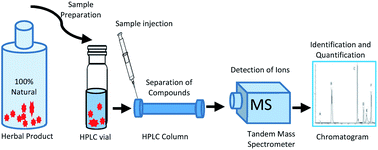A HPLC-MS/MS method for screening of selected antibiotic adulterants in herbal drugs
Abstract
The use of herbal products adulterated with conventional drugs increases the risk of developing microbial resistance and causes herb-to-drug interaction, leading to severe clinical consequences. The complex nature of herbal products has been a challenge for the unambiguous identification of adulterants. The improved analytical selectivity and sensitivity of hyphenated techniques such as high performance liquid chromatography-tandem mass spectrometry (HPLC-MS/MS) enable the confirmatory screening of adulterants in herbal products. Simultaneous screening of adulterants is necessary and efficient because it has been established that more than one chemical adulterant may be present in one herbal product. An HPLC-MS/MS method for the simultaneous detection and quantification of amoxicillin, ampicillin, metronidazole, ciprofloxacin, sulfamethoxazole, and trimethoprim in powdered herbal drugs was developed. Deuterated metronidazole-d3, trimethoprim-d3, ciprofloxacin-d8, and sulfamethoxazole-d4 were used as internal standards (ISs). For each analyte, two transitions were monitored using protonated molecules as precursor ions. The extraction of analytes from herbal products was performed using a simple methanol : water : formic acid (90 : 10 : 0.05, v/v) extraction solvent. Chromatographic separation was done in a gradient of 0.01% formic acid in methanol and 0.01% formic acid in MilliQ water. The calibration curves were linear (r2 ≥ 0.996) over the range of 0.005–2.5 μg mL−1 for all compounds except metronidazole, whose range was 0.005–1 μg mL−1. The limit of detection (LOD) ranged from 0.012 to 0.046 μg mL−1, while the limit of quantification (LOQ) ranged from 0.066 to 0.153 μg mL−1. The accuracy, expressed as the recovery of spiked herbal products, ranged from 45% to 114%. The precision, expressed as relative standard deviation (RSD) at two concentration levels, ranged from 1.6% to 15.9%. The matrix effect expressed as the matrix factor (MF) ranged from 0.79 to 0.92. The developed method was applied to powder herbal products purchased in Tanzania. Amoxicillin, ampicillin, trimethoprim, sulfamethoxazole, and ciprofloxacin were not detected in all samples. Metronidazole was detected in eight samples with the highest concentration of 1.38 μg g−1. The developed method is suitable for the detection of all the studied antibiotic adulterants in herbal products. Quantification can be performed for all the compounds except ciprofloxacin due to its lower recovery.



 Please wait while we load your content...
Please wait while we load your content...